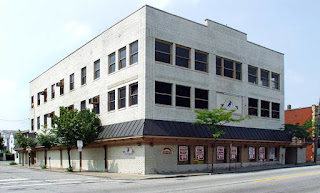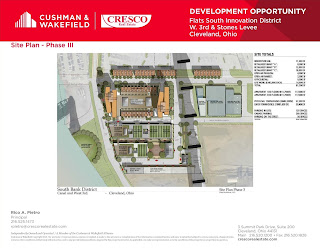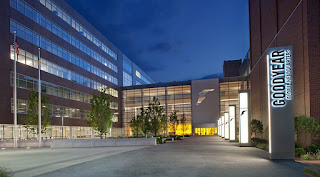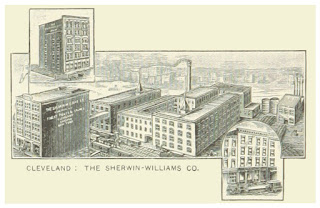Substitute Senate Bill 39, to create a tax credit for insurance companies to invest in Transformational Mixed Use Developments (TMUDs), could aid several big real estate developments in Cleveland.
If the legislation continues on what appears to be a new, fast track, it could become law as early as next month.
There was little visible activity surrounding Sub. SB 39 since it passed the Ohio Senate 32-1 on June 25. It was introduced into the House of Representatives the following day. But there had been no action on the bill since it was referred to the Economic & Workforce Development Committee on June 30.
That changed this month when three hearings were scheduled, with Sub. SB No. 39 being the only legislation on the committee's docket. The bill could be reported out of the committee as early as Oct. 30 or Nov. 6 for a vote by the full House, with as many as a half dozen House sessions available in November for the House to pass it.
The House may move the bill quickly as it had already passed a similar bill, House Bill 469, last year by a 91-0 vote. It came after six hearings over two months in the House Government Accountability and Oversight Committee. But the legislative session expired before the Senate could pass it.
Originally drafted by Thompson Hine LLP at the request of Stark Enterprises, the legislation would allow an insurance company investor to fill a missing piece in the capital stack for Stark's nuCLEus development in downtown Cleveland. In fact, a source said the $350 million, 2-million-square-foot project couldn't move forward without it.
new nuCLEus presentation with more detailed images about the project.
The presentation heavily promoted the office building, more half of which is already spoken for by prospective tenants. And it promoted specific retail spaces, the rentable areas of those spaces, and noted that the spaces would become available in "March 2020." While tax abatement is available from the city for residential real estate it is not available for commercial development.
Ezra Stark, chief operating officer, of Stark Enterprises did not respond to an e-mail seeking comment for this article.
NuCLEus is proposed to feature two 24-story buildings, one for residential and the other for offices, atop a muli-story pedestal of parking and retail between Prospect Avenue and Huron Road at East 4th Street. NuCLEus is pursued by a partnership called Gateway Huron LLC, comprised of Stark Enterprises and J-Dek Investments Ltd.
For a development to be considered a TMUD it must include a mix of land uses, have a development cost of more than $50 million and be 15 or more stories in height or at least 350,000 square feet. The bill authorizes a nonrefundable insurance company tax credit of up to 10 percent of total eligible project costs for contributions of capital to eligible projects.
Ohio Senator Kirk Schuring (R-29, Canton) is sponsoring Sub. SB 39. The bill has 18 bipartisan co-sponsors. Schuring delivered his sponsor testimony Oct. 16 to the House Government Accountability and Oversight Committee.
"Sub. SB 39 will have a catalytic effect on the surrounding areas where these mega projects are constructed," Schuring testified. "It will trigger an economic chain reaction that truly will be transformational, fostering new retail establishments, new office buildings, new residential facilities and new entertainment venues. In short, it will be a vibrant place where people will want to live, work and play."
It isn't known if the new Sherwin-Williams (SHW) headquarters and research & development facilities, likely to be built in downtown Cleveland, would be eligible for the TMUD tax credit. It has been assumed that SHW would pay for the roughly $1 billion project from its own significant net cash flow, which is nearly $2 billion per year.
But if an insurance company did invest in SHW's new HQ+R&D under the TMUD program, it could create a roughly $100 million public incentive to build the anticipated 1.8-million-square-foot project in Ohio. Sources say that up to $200 million in public incentives from the city, county and state were pledged to SHW to build its new HQ+R&D in Cleveland.
A week after Senator Schuring testified, on Oct. 23, Frank Sinito, CEO of Cleveland-based Millennia Group of Companies, testified before the committee that redevelopment of its 1.3-million-square-foot Centennial building couldn't happen without Sub. SB 39. The Centennial is the former Huntington Bank building at 925 Euclid Ave.
The renovation of existing buildings often results in much lower efficiency factors in the range of 65 percent as opposed to new construction which is usually 85 percent and above. Of the 1.3 million square feet in The Centennial, over 350,000 square feet is non-income producing circulation and other space.
"The rents from the other income-producing areas of the building simply are not sufficient to subsidize the costs associated with these very large but non-income-producing areas of the building," Sinito testified.
"So, given these realities, it is very important to see -- and I think it becomes quite clear -- that existing buildings often have an even greater need for the type of financial assistance that SB 39 is intended to provide than new construction does," he added.
In his testimony before the Senate Finance Committee in April, Stark Enterprises CEO Robert Stark said that the TMUD tax credit wouldn't be a replacement for the limited-duration and since-expired "catalytic" historic tax credit. Instead, it would apply equally to new construction and foster investment in the future of Ohio's cities.
"We're seeing an international phenomenon of re-urbanization," Stark said. "We're faced with attracting and keeping the best and the brightest. To do that requires a culture of an interconnected, collaborative society and undoing the isolationism of sprawl."
END
Saturday, October 26, 2019
Wednesday, October 23, 2019
Cleveland neighborhoods win $9 million to boost development
JPMorgan Chase is investing $5 million over three years to expand access to opportunity in Cleveland's target neighborhoods so more residents can share in the rewards of a growing economy. This investment is part of the company's sixth Partnership for Raising Opportunity in Neighborhoods (PRO Neighborhoods) competition to support neighborhood development projects and promote inclusive growth across communities in the U.S.
Cleveland is one of only seven winning submissions in this year's national competition for philanthropic funding. Overall this year, JPMorgan Chase received 75 applications covering 49 U.S. cities to support capital and planning projects. The successful application was submitted by Cleveland Development Advisors, the real estate and business development financing affiliate of the Greater Cleveland Partnership, and Finance Fund Capital Corporation, a nonprofit real estate developer serving Ohio.
Cleveland Development Advisors will add $3.75 million to JPMorgan Chase’s commitment, and form and oversee a revolving loan fund that will offer qualifying developers financing at below market lending rates. Finance Fund Capital Corporation will provide real estate technical assistance.
These neighborhoods have an average poverty rate of 44 percent and an unemployment rate of 25 percent, which exceeds the city’s overall poverty rate of 31 percent and jobless rate of 18 percent.
The nearly $9 million in commitments will be coupled with other incentives to attract projects that residents of the neighborhoods have identified as top priorities: affordable housing, access to fresh food and greenspace, access to living wage jobs, workforce development, digital connectivity and support of small businesses and minority entrepreneurs.
"This commitment from JPMorgan Chase and the matching loan funds from Cleveland Development Advisors will give us another significant tool to leverage new investments aimed at benefitting residents of the Clark-Fulton, Glenville and Buckeye-Kinsman neighborhoods," Mayor Frank Jackson said. "These funds will complement my Neighborhood Transformation Initiative, which has designated all or parts of these neighborhoods for economic development funding and other assistance."
Yvette Ittu, Cleveland Development Advisors President, said the new funds will help to attract additional incentive financing including Opportunity Zone funds to these neighborhoods. Federally-sanctioned Opportunity Zones offer tax breaks for investors as an incentive to attract and assist development projects in designated areas.
"We're very focused on trying to attract projects to these neighborhoods that will improve the lives of the residents there," Ittu said. "These dollars complement our work, and our community's work, by strategically investing in neighborhoods that can benefit from it the most. This grant from JPMorgan Chase – when bundled with the city's incentives, other public and private monies and the Opportunity Zone designations – allows us greater ability to attract, encourage and assist investment and development to empower these neighborhoods."
Since 1989, Cleveland Development Advisors has invested nearly $450 million in more than 135 projects in Greater Cleveland that have resulted in 6,750 new housing units and seven million square feet of commercial space.
Cleveland City Councilman Blaine Griffin, whose ward includes a neighborhood selected for the new investments, lauded the announcement.
"This is great news for three Cleveland neighborhoods that have experienced years of abandonment, disinvestment and neglect," said Councilman Griffin. "And I commend JPMorgan Chase and Cleveland Development Advisors for this infusion of much needed capital that will surely help in the revitalization efforts already happening in these neighborhoods."
Finance Fund Capital Corporation has worked with Cleveland Development Advisors previously on a wide range of community development projects in the Cleveland area. The organizations will partner in working with the neighborhoods and local community development corporations including Famicos, MetroWest and Burten Bell Carr.
"This investment from JPMorgan Chase gives us another opportunity to work successfully with Cleveland Development Advisors to help create positive change in Cleveland neighborhoods driven by local residents," said Diana Turoff, President and CEO of Finance Fund Capital Corporation. "Our past working relationships with Cleveland Development Advisors and neighborhood organizations in Cleveland give us a strong foundation upon which to build. We look forward to working with them as well as local residents and leaders to cultivate sustainable growth in these three neighborhoods."
The Glenville, Clark-Fulton and Buckeye/Kinsman neighborhoods were chosen by the applicants for the Chase grant application based on a study by Cleveland State University that identified areas in Cleveland with Opportunity Zone designations where focused planning could attract private investment to the benefit of existing residents and businesses.
END
Thursday, October 17, 2019
Lakewood's East End gets some refreshments
The latest and largest transaction occurred Oct. 16 when Jim Miketo, owner of Forest City Shuffleboard in Ohio City, acquired a three-story, 101-year-old, mixed-use building at 12501 Madison Ave., county records show. It recently hosted the Madison Bi-Rite grocery store and Silhouette School of Dance.
Starting in mid- to late-2020, Miketo plans to transform the upper two-thirds of the 30,588-square-foot building into approximately 20 new apartments, according to real estate brokerage Cresco which handled the property sale. The rest, about 9,000 square feet, will feature ground-floor retail fronting busy Madison, the main street of Lakewood's Birdtown neighborhood.
Along with converting the property into apartments over retail, Miketo proposes to offer a new fitness center, dedicated parking, outdoor spaces for grilling and an expansive rooftop deck that promises to offer views of Lake Erie and downtown Cleveland's skyline.
“We are all about elevating historic neighborhoods and galvanizing communities while bringing new and unique developments to the area,” Miketo said in Cresco's Oct. 16 blog. “This property is a cornerstone building in a community that has incredible historic significance and a thriving demographic. We’re beyond excited to be able to contribute to such a beautiful neighborhood and help continue its rich legacy.”
 |
| This is how 12501 Madison Ave. looked until its grocery store closed two years ago. It has sat vacant ever since (Cresco). |
Another important property sale took place in July. Gregory Rossi of Rocky River bought the property at 11824 Detroit Ave. that contained the former Maria's Roman Room restaurant for 44 years until it closed in 2005.
"He is opening a sports bar called the Ohio Inn," said Ward 4 Councilman Dan O'Malley. "When I talked to him over the summer, he was ambitiously hoping to open for football season. Obviously it's not yet open, but it's progressing."
Rossi has installed new windows and doors in the 96-year-old, 4,870-square-foot building that contains the restaurant on the first floor and apartments above. O'Malley said Rossi doesn't own any other restaurants or bars in the Cleveland area but said he may have owned an establishment previously in the Youngstown area.
According to LoveLakewood.com, Maria and Anthony "Chick" Bastulli owned and operated Maria's Roman Room for 44 years before she sold the restaurant business in early 2005 to Leonard and Olga Fink, according to Lakewood Patch. The restaurant has been closed since 2009. Maria Bastulli passed away in 2017.
| The building at 11824 Detroit Ave. that was home to Maria's Roman Room for 44 years until 2005. At left is the driveway to the Value World store and municipal parking lot (Google). |
Rossi, under the name 11824 Detroit LLC, bought the restaurant property for $350,000 on July 10, according to Cuyahoga County records that were later corrected on Sept. 6.
Another property transaction occurred June 27 when the city acquired the closed Cove United Methodist Church, 12525 Lake Ave., for $900,000. The city had been looking for a large, underutilized property for it to build additional capacity for aging storm and sanitary sewers at Lakewood's East End.
With this large, 1.765-acre property, the city will be able to install an underground sewer retention tank and possibly retain the church for a future civic use like a community center. Or it could be demolished for development, considering the rising rents and low vacancies in the Gold Coast area. That will be decided after the sewer project, city officials said.
More refreshments are coming to the city's East End. City officials are planning some modest streetscape improvements in the Rockport area, including new pole-mounted traffic lights on Detroit Avenue for the Coutant Avenue and Ridgewood/Cove Avenue intersections as well as renovations to the pocket park on Clifton Prado, O'Malley said.
END
Wednesday, October 16, 2019
Planning starts for cross-county Lake Erie trail, erosion control
Cuyahoga County Executive Armond Budish announced $500,000 for conceptual-level planning for the cross-county Lake Erie Trail along more than 30 miles of the county's shoreline.
Funding will come from the county, the Cleveland Metroparks, the Northeast Ohio Areawide Coordinating Agency's (NOACA) Transportation for Livable Communities Initiative, the Cleveland Foundation and others.
The model for this program is the City of Euclid's waterfront improvements plan. Like most of Cuyahoga County, Euclid has two basic problems involving Lake Erie: lack of public access to the lake and an ongoing shoreline erosion challenge.
 |
| Lakewood is another Cleveland suburb that has invested in its lakefront, including the Solstice Steps and Promenade seen here at Lakewood Park (Environmental Design Group). |
To protect those properties and to increase their values, the City of Euclid is investing up to $19 million to construct a 10-foot-wide lakefront trail to link several high-rise apartment complexes with the Kenneth J. Sims Park. The trail is aligned behind an erosion-resistant barricade comprised of two-ton limestone boulders and concrete retaining walls.
 |
| Construction on the first phases of Euclid's waterfront improve- ment project got underway in November 2018 (City of Euclid). |
Euclid used a mix of local tax-increment financing from the higher property values, Cuyahoga County Casino Revenue Funds and Federal Emergency Management Agency grants through a pre-disaster mitigation program.
There are already five miles of publicly accessible, dedicated trails along Cuyahoga County's lakefront, located at Huntington Park, Lakewood Park, Edgewater Park, Gordon Park and the new Lakefront Bikeway along the West Shoreway.
It doesn't include the unimproved, non-dedicated (not traffic-separated) Lakefront Bikeway in North Marginal Road along the East Shoreway, or other locations lacking non-dedicated biking/hiking infrastructure.
Once completed, the cross-county planning effort will prioritize investments based on costs-benefits and provide guidance for the next steps -- namely, more detailed engineering and environmental documentation.
END
Tuesday, October 15, 2019
Scranton Peninsula's first major project gets a little denser
 |
| NRP Group's revised plan for developing a residential complex along Carter Road on Scranton Peninsula in the Flats (BKV). CLICK IMAGES TO ENLARGE |
The new plan features 315 apartments in two buildings plus 15 townhomes. The site plan reduces the amount of surface parking while preserving the total number of spaces by providing a two-level parking deck. It also offers the semblance of a street grid, removes gated entrances and puts buildings up close to the street.
A source said that as Scranton Peninsula develops, the NRP site can be rearranged a bit and tied in with surrounding developments. NRP Group has an option to buy 7.44 acres of land from the so-called Thunderbird development site led by Fred Geis, East-West Alliance and J-Roc Development.
The Avian at Thunderbird, located at about 1950 Carter Rd.
NRP Group added so much parking at Scranton Peninsula because of their experience in providing so little parking at The Edison At Gordon Square, 6060 Father Caruso Dr. That development, which opened in 2017, has fewer than one parking space for each of the 306 apartments.
The source said that residents complain about the lack of parking and the frequency of car break-ins. NRP Group reportedly is concerned the development won't be successful without the parking since Scranton Peninsula is even more isolated and less walkable than the north end of Gordon Square where The Edison is located.
NEOtrans first broke the story in May of NRP Group seeking to acquire land and proposing to build several hundred apartments on Scranton Peninsula. NRP has shelved plans for building a 323-unit phase two of the Edison on the south side of Breakwater Avenue in Gordon Square.
NRP officials also reportedly considered developing one of several sites on Cleveland's near-West Side. But those were too close to The Edison and might have put NRP in competition with itself for residents. Scranton Peninsula was considered a unique setting for NRP's latest housing products in Cleveland.
In June, NRP announced it is partnering with MetroHealth Medical Center on developing a $60 million, 250-unit residential development near the hospital along West 25th Street in the Clark-Fulton neighborhood.
END
Monday, October 14, 2019
Sherwin-Williams HQ+R&D will be in downtown Cleveland
By the end of this month, SHW reportedly expects to announce the site for its new HQ+R&D, according to two sources. The approximately $1 billion, 1.8-million-square-foot HQ+R&D will be built adjacent to each other on whatever site is chosen and they will consolidate up to 6,000 SHW employees from throughout Northeast Ohio, Minneapolis and potentially other locations.
Among the existing, cramped and aging HQ+R&D facilities (Landmark Building and John G. Breen Technology Center), SHW totals 3,300 employees in downtown Cleveland. It has another 1,100 office and research employees scattered throughout Northeast Ohio that could be consolidated. Furthermore, about 1,600 jobs would be added through corporate growth or relocated here from other states, namely as a result of SHW's acquisition of rival Valspar.
For "weeks," SHW has been negotiating with the legal representatives of owners of up to four sites -- and two in particular, two sources say. SHW will take the best deal offered by the property owners.
All four sites are in downtown Cleveland. SHW has received proposals for sites outside of downtown Cleveland but, according to sources, SHW is not negotiating the terms of acquiring non-downtown sites.
The four downtown sites identified by SHW and its project consultant Welty Building Co. are:
1. Jacobs/Weston: West of Public Square, a total of 8.93 acres of parking lots owned by the Jacobs Group and the Weston Group would provide the site for a connected, urbanized office campus. It would be fully integrated into the amenities of a major city's central business district. The city and county also may be interested in this site for a new Justice Center complex, however.
 |
| An unofficial massing of a SHW HQ+R&D campus on the Jacobs/Weston lots west of Public Square (Geowizical). |
Eaton Corp. proposed building a new HQ on 9 acres at the northern edge of the Flats East Bank district on mostly Cleveland-Cuyahoga County Port Authority-owned land. But SHW's needs are potentially larger and might need to expand onto parking lots to the east or south.
 |
| The last time a major corporate headquarters was planned on the lakefront, it was proposed to be built north of the Flats East Bank development, shown here (Wolstein/Fairmount). |
 |
| Flats South Innovation District, as proposed at full build-out by Joel Scheer, was heavy on residential with less restaurant/ retail and even less office/live-work space (Cresco). |
But if the city and county are intransigent about wanting to build the new Justice Center complex here, then SHW would turn to the Bedrock riverfront site. Two sources say SHW has been negotiating with Bedrock's lawyers at Taft Stettinius & Hollister LLP for "weeks."
Again, a stunning tower of up to 40 stories would be this site's most prominent feature, but so would the riverfront which is so prominent in the Fortune 500 company's long history. There, Breen Center would be expanded or replaced.
Notice that SHW publicly announced its HQ+R&D project on Sept. 12 although it solicited proposals starting in August. Its deadline for solicited proposals was Sept. 25. That suggests SHW wasn't very serious about accepting proposals except for those that Welty was able to generate. And Welty generated only downtown Cleveland sites for SHW's consideration, although unsolicited proposals were accepted in that two-week window.
Who will build SHW's new HQ+R&D?
 |
| Goodyear Tire & Rubber Co.'s new Akron HQ was built near to where the company was founded in 1898. Welty Building and Gilbane Building Co. partnered on the project (Goodyear). |
Welty also has significant political connections including former Lieutenant Governor Mary Taylor who now chairs Welty's Finance Committee and is married to Welty President & CEO Don Taylor.
A campaign to retain the HQ+R&D facilities in Cleveland was formed under the leadership of Gov. Mike DeWine and overseen by retired Forest City Enterprises CEO Albert Ratner.
That campaign reportedly has amassed $200 million in pledged public incentives to SHW, a source said. Such an amount represents an insurance policy against any incentive package offered by other cities or states to pay what would have been SHW's substantial relocation costs.
 |
| Sherwin-Williams' headquarters and first factory occupied a growing area of land in 1891 along Canal Road and the Cuyahoga River where the Breen Center stands (SHW). |
Welty and Gilbane have several HQ credits on their resumes. Welty provided construction services at the Dealer Tire LLC HQ in Cleveland, Goodyear's new HQ in Akron and the Timken World HQ in Canton. Welty also worked with Scheer on his Settler's Point development in the Flats, which is home to Welty's Cleveland office. Its main office is in the Akron suburb of Fairlawn.
Gilbane built the 20-story Ernst & Young Building at Flats East Bank in 2012, the last office tower built in downtown Cleveland. Gilbane also teamed with Welty on the Goodyear HQ. Goodyear's HQ reportedly impressed SHW CEO John Morikis.
Last week, NEOtrans reported that Morikis and his wife moved in March into a new 22,197-square-foot primary residence they built in Bay Village. It offered a reasonable argument that SHW's HQ wasn't going anywhere but within the Greater Cleveland area, despite media overreactions since SHW's Sept. 12 announcement of plans to build a new HQ+R&D facility.
END
Wednesday, October 9, 2019
Sherwin-Williams HQ and CEO are finding new homes
Chances are, you'd probably build it in the same metro area where your new headquarters will be located.
According to public records, Mr. and Mrs. John G. Morikis put the finishing touches earlier this year on their beautiful, brand-new 22,197-square-foot mansion. They moved in in March. Mr. Morikis, if the name doesn't immediately ring a bell, is the CEO of Sherwin-Williams Corp. (SHW).
As most of Greater Cleveland is almost certainly aware by now, SHW announced publicly in September that it is looking at establishing a new global headquarters building and research facilities for the the Fortune 500 company.
Morikis said SHW will consider multiple potential sites, including locations in Cleveland, Northeast Ohio and several other states.
So where did Mr. and Mrs. Morikis build their new home? At 24300 Lake Road in the Cleveland suburb of Bay Village.
It isn't known how much the Morikis' paid to build and landscape their dream house. But a 9,073-square-foot house on 0.92 acres with a lake view, set eight houses farther west at 24524 Lake, sold in June for $3.65 million, county records show. That's $402 per square foot. On that score, the Morikis' 22,197-square-foot house and 2-acre property could be valued at up to $10 million.
Some suggested that SHW might move to Brecksville because they thought Morikis still lived there. And, DiGeronimo Cos. was making a vocal case that the global coatings firm should at least put its new, consolidated research and development facility and possibly its HQ at DiGeronimo's Valor Acres development in Brecksville.
Hopefully no one is wondering. But just in case they are, it should be said that Bay Village, a built-out bedroom community, isn't in contention for SHW's HQ+R&D. No sources have suggested that Westlake, Avon or Avon Lake are in contention either.
 |
| View of Lake Erie, Lakewood and downtown Cleveland in the distance, as seen from the Morikis' property (realtor.com). |
Morikis knew of Cook in her role since 2009 as vice president of strategic facilities planning at Eaton Corp. In other words, Cook was in charge of building Eaton's new HQ that opened in 2012 in Beachwood. By the way, the word is that Morikis isn't a fan of Eaton's new HQ.
SHW principal offices have been located in downtown's Landmark Office Tower, 101 W. Prospect Ave., since 1930. It outgrew that 900,000-square-foot building in 2014, spreading up to 4,400 employees into numerous buildings in Northeast Ohio.
But the 2014-15 effort to build a new SHW HQ was shelved when the opportunity arose to buy rival coatings firm Valspar in 2016. Since then, SHW is on an increasingly speedy glidepath to pay down debt from the Valspar acquisition, possibly returning to a coatings industry standard 1:1 debt-to-equity ratio by 2022.
SHW reignited planning for new HQ+R&D facilities more than a year ago, around the time NEOtrans first got wind of it. Up to 1.8 million square feet of new facilities are planned. Any transition to new HQ+R&D facilities is not expected to occur until 2023 at the earliest, SHW officials have said.
 |
| A 3,965-square-foot house built in 1990 by David and Carol Panacoast was demolished in 2015 to eventually make way for the Morikis' grand mansion (movoto.com). |
The Morikis' house was built on the site of a 3,965-square-foot, four-bed, four-bath house built in 1990, and listed for sale in 2014 at $900,000 per movoto.com. That home was built by David and Carol Pancoast, the latter serving on the Bay Village school board for 28 years. She died in February 2014, 4 1/2 years after her husband passed. Cook bought the property in September 2014 and demolished the Pancoast house in 2015.
And in case you were wondering, Morikis shortened his commute to downtown Cleveland by moving to Bay Village. Google Maps show that his drive in light traffic between his old Brecksville home to 101 W. Prospect via Interstate 77 was 17.8 miles and 27 minutes each way. That dropped to 12.7 miles and 18 minutes each way between his new Bay Village address and his downtown office.
BTW, when Interstate 90 gets bogged down in traffic, Morikis has the option of taking U.S. Route 6 (Clifton/West Shoreway) which is just 11.9 miles and 20 minutes in light traffic. And it's often a less stressful trip that takes commuters past some great restaurants and Edgewater Park.
There are unsubstantiated rumors that SHW may announce the location of its new 1.8-million-square-foot HQ+R&D facilities in a month or less. And there is reportedly a substantial public incentive package with SHW's name on it. One wonders if city, county and state officials knew about the CEO's new crib before packing their gift basket to SHW.
It's doubtful that knowledge would have made a difference. Certainly a brand-new, roughly $10 million home of SHW's CEO doesn't prove that SHW will stay in Cleveland. But it is a powerfully fragrant tea leave that's hard to avoid reading.
END
Subscribe to:
Posts (Atom)












